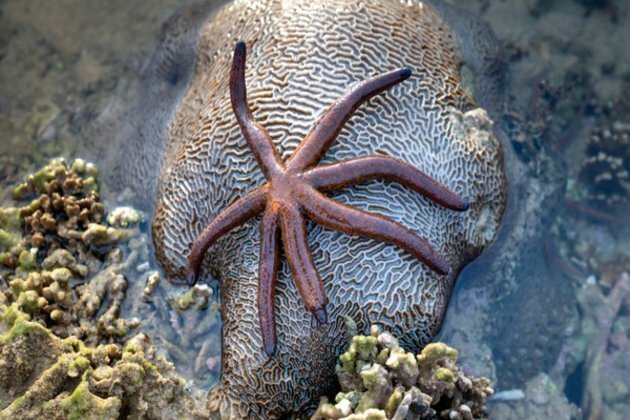Scientists detect sea star hybridization in North Atlantic Ocean
ANI
11 Sep 2023, 16:48 GMT+10

New York [US], September 11 (ANI): In the chilly waters of the North Atlantic Ocean, scientists have long speculated that two kinds of sea stars-commonly known as starfish-found along the rocky coastlines of Europe and North America may have interbred.
Hybrid starfish are already present and prospering along the coasts of New England and the Canadian Maritimes, according to freshly analysed genomic data.
A new study, published in the journal Molecular Ecology, presents genomic evidence of hybridization between two closely related species of sea stars- Asterias rubens, the common starfish, and Asterias forbesi, known as Forbes' sea star.
"It is the first genome-wide evidence of extensive hybridization in an ecologically important coastal species," said corresponding author Melina Giakoumis, who is a PhD candidate with the Graduate Center's Biology program and associate director of the Institute for Comparative Genomics at theAmerican Museum of Natural History.
The biologists set out to find whether the sea stars were crossbreeding in the wild, and if so, what environmental factors influenced its occurrence. The researchers took DNA samples from both species at 33 sites in the North Atlantic and then conducted DNA sequencing that included samples from Asterias amurensis, the Northern Pacific sea star, used as a control group.
Through the genomic data, the scientists found that widespread hybridization had occurred between the two species of sea stars from Cape Cod to Nova Scotia.
The sea stars were shown to have different environmental preferences: A forbesi has a limited geographic range with adaption to local environments, and A rubens have a wider range that extends all the way to Western Europe. These preferences are also apparent in their genomes, the researchers said.
The study's species distribution models accurately predicted hybrid zones to occur where these ranges overlapped - the Gulf of Maine being at the centre of hybridization - suggesting that environmental selection played an important role in the preservation of hybrid zones. Additionally, the results indicate that A. forbesi has a higher tolerance for warmer temperatures, while A rubens prefers colder habitats, and hybrids are found in areas with temperatures that are tolerable by both species. The study highlights the ecological importance of both sea stars, considered to be"keystone species" with significant impacts on surrounding marine communities. When they're removed from their intertidal communities-the coastal zones between high and low tide-diversity among those entire ecosystems has been shown to collapse, Giakoumis said.
"Two questions arise from this study," said Michael Hickerson, a biology professor with the CUNY Graduate Center and City College of New York, and Giakoumis' advisor.
"Will the hybrids' move to follow the changes in sea surface temperatures accelerate to the point of one species replacing the other? Or will they rescue the two species by being a source of gene combinations that allow greater resilience to climatic changes due to increased adaptive variation?"Since sea stars preferentially eat dominant competitors, they provide stability to the ecosystem," the biologist explained. "These species are therefore crucial to study for marine conservation, as they have rippling effects throughout the rest of the community."Giakoumis notes that the Gulf of Maine is warming faster than 99 per cent of the global ocean.
"Our results imply that the distribution of genomic variation in North Atlantic sea stars is influenced by the environment, which will be crucial to consider as the climate changes," she adds.
Hybridization is believed to be common in nature, Giakoumis points out, and it has been observed more often as genomic data expands.
As the first study to offer genome-wide proof of hybridization in these sea star species, the research supports the work of evolutionary biologists and other scientists who study intertidal ecology, the authors said, with possible implications for wildlife management and protection of intertidal zones in the North Atlantic. (ANI) Share
Share
 Tweet
Tweet
 Share
Share
 Flip
Flip
 Email
Email
Watch latest videos
Subscribe and Follow
Get a daily dose of New York Statesman news through our daily email, its complimentary and keeps you fully up to date with world and business news as well.
News RELEASES
Publish news of your business, community or sports group, personnel appointments, major event and more by submitting a news release to New York Statesman.
More InformationBusiness
SectionTesla struggles as sales drop and competition rises
AUSTIN, Texas: Tesla's early-year performance has taken a hit, as sliding sales, rising competition, and CEO Elon Musk's growing political...
India’s jewellery exports hit by US tariffs
MUMBAI, India: India's jewellery exporters are facing their toughest year in over a decade as fresh U.S. tariffs threaten to cut off...
Mitsubishi eyes role in Alaska’s LNG export project
TOKYO, Japan: Mitsubishi Corp is weighing a potential role in Alaska's ambitious LNG export project, as the Japanese trading giant...
Netflix expands language tools to boost global viewing
LOS GATOS, California: As international content fuels its global growth, Netflix is expanding its language tools on TV to help users...
Artificial Intelligence landscape becoming more competitive
Artificial intelligence (AI) has seen rapid growth, transforming industries and daily life. From chatbots to advanced generative models,...
Job growth signals strength amid economic uncertainty
WASHINGTON, D.C.: U.S. private sector hiring exceeded expectations in March, suggesting some underlying strength in the labor market...
International
SectionPhilippines says F-16 purchase not targeting China, any others
MANILA, Philippines: A Philippine security official stated that acquiring F-16 fighter jets from the United States will not harm any...
Amazon set to launch first project Kuiper satellites
WASHINGTON, D.C.: Amazon.com has announced that it will launch the first 27 satellites for its Project Kuiper internet network this...
More than 400 aid workers killed in Gaza since October 7 2023
NEW YORK, New York - UN Secretary-General Antonio Guterres has voiced profound concern over the escalating human toll in Gaza, as...
Billionaire Kretinsky clears final hurdle in Royal Mail takeover
LONDON, U.K.: Daniel Kretinsky's path to owning Royal Mail is nearly complete, as his firm EP Group announced this week that all regulatory...
AP study: MLB average salary hits $5 million for first time
NEW YORK CITY, New York: Major League Baseball (MLB) players now earn an average of over US$5 million per year for the first time,...
Former coal plant to become $10 billion data center for AI, Cloud
HARRISBURG, Pennsylvania: The owners of Pennsylvania's largest former coal power plant plan to turn it into a US$10 billion natural...













